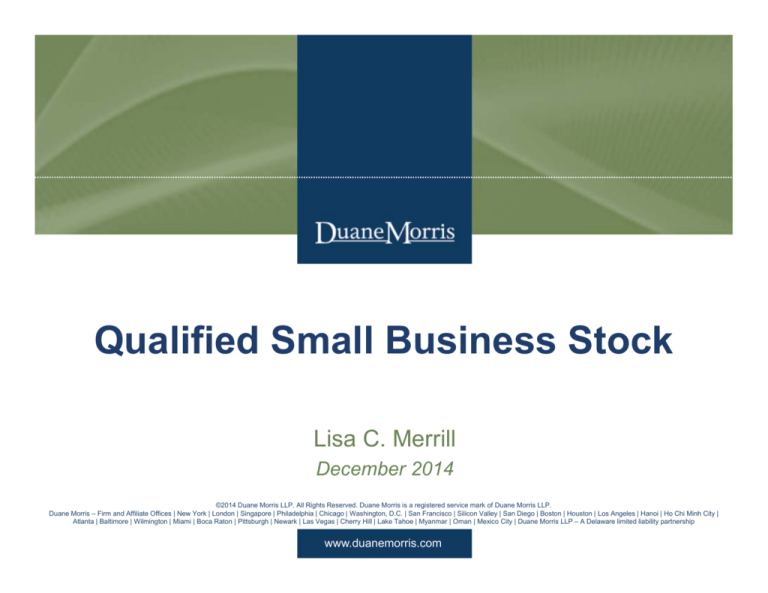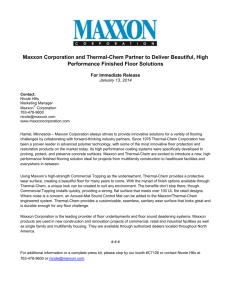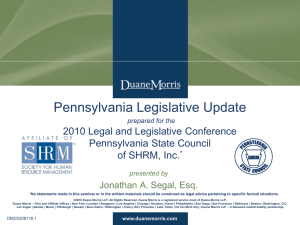
Qualified Small Business Stock
Lisa C. Merrill
December 2014
©2014 Duane Morris LLP. All Rights Reserved. Duane Morris is a registered service mark of Duane Morris LLP.
Duane Morris – Firm and Affiliate Offices | New York | London | Singapore | Philadelphia | Chicago | Washington, D.C. | San Francisco | Silicon Valley | San Diego | Boston | Houston | Los Angeles | Hanoi | Ho Chi Minh City |
Atlanta | Baltimore | Wilmington | Miami | Boca Raton | Pittsburgh | Newark | Las Vegas | Cherry Hill | Lake Tahoe | Myanmar | Oman | Mexico City | Duane Morris LLP – A Delaware limited liability partnership
www.duanemorris.com
Purpose of Favorable Tax Treatment
•
•
•
Stimulate investment in start-up companies.
Allows investors to receive favorable income tax treatment
of the capital gain earned on early stage investments.
Favorable income tax treatment consists of (i) full or partial
gain exclusion or (ii) rollover of gain.
www.duanemorris.com
Overview of Discussion
•
•
•
First, discuss the rules for gain exclusion.
Second, discuss the rules for tax-free rollovers.
Third, discuss the definition of “qualified small business
corporation stock.”
www.duanemorris.com
Exclusion of Gain – IRC 1202
•
•
•
Under IRC Section 1202, a taxpayer, other than a
corporation, may exclude some or all of the gain on the
sale or exchange of qualified small business stock
(“QSBS”).
The amount of the exclusion depend on when the QSBS
was acquired and whether the issuer is in an
“empowerment zone” (certain geographic areas
designated by HUD or USDA).
There is no exclusion for gain attributable for periods after
12/18/2018.
www.duanemorris.com
Exclusion of Gain
•
•
•
•
Noncorporate taxpayers can exclude from gross income
50% of any gain from the sale of QSBS held for more than
5 years.
The exclusion is 75% for QSBS acquired after 2/17/2009
and before 2/28/2010.
The exclusion is 100% for QSBS acquired after 9/27/2010
and before 1/1/2014.
The exclusion is 60% for QSBS issued by a corporation in
an empowerment zone.
www.duanemorris.com
Limitations on Exclusion
•
For any one taxpayer, the maximum amount of eligible
gain with respect to the stock of a single issuer that may
be subject to the partial exclusion is no more than the
greater of:
–
–
$10,000,000 reduced by the aggregate amount of eligible gain
taken into account by the taxpayer under §1202 in prior taxable
years with respect to stock of the same issuer; or
10 times the aggregate adjusted bases of QSBS of that issuer
disposed of by the taxpayer during the taxable year.
www.duanemorris.com
Limitations on Exclusion – Example
B and C each purchases QSB stock in X corporation for $500,000. B also
purchases QSB stock in Z corporation for $2,000,000. X corporation and Z
corporation are unrelated. B and C sell all of their stock. All of the
requirements of §1202 are met. All transactions are assumed to be subject
to the 50% exclusion.
• B sells her X corporation stock for $12,000,000. Of B's gain, up to
$10,000,000 is subject to §1202. Therefore, assuming a 50%
exclusion, B excludes $5,000,000 of gain from gross income with
respect to the sale of the X corporation stock. B recognizes a gain of
$6,500,000.
• C sells his X corporation stock for $11,500,000. Of C's gain, up to
$10,000,000 is subject to §1202, and, assuming a 50% exclusion, C
excludes $5,000,000 from gross income. Therefore, C recognizes gain
of $6,000,000.
www.duanemorris.com
Exclusion Not Available
•
•
Stock issued to a taxpayer cannot qualify for the exclusion if the
issuing corporation redeems its own stock from the taxpayer or
persons related to the taxpayer, within the four-year period beginning
two years before the issue date. 2% de minimis exception applies.
Stock will also not qualify for the exclusion if the issuing corporation
engages in a “significant redemption,” which occurs if the corporation,
within a two year period beginning one year before the issuance of the
stock, redeems stock with an aggregate value exceeding 5 percent of
the aggregate value of all the corporation stock. 2% de minimis
exception applies.
www.duanemorris.com
Tax Rate
•
•
•
A taxpayer is not entitled to both the gain exclusion for
QSBS and the reduced capital gain rates.
Generally, the 28% rate will apply to the gain which is not
excluded under IRC 1202.
Note that a portion of the excluded gain may be treated as
a preference item for the purposes of the Alternative
Minimum Tax (n/a to stock acquired between 9/27/10 and
1/1/14).
www.duanemorris.com
Rollover of Gain – IRC 1045
•
Taxpayers other than corporations may elect to “roll over”
capital gain from the sale of QSBS held for more than six
months into new QSBS stock.
www.duanemorris.com
Rollover of Gain – Requirements
Provided that:
• The taxpayer is not a corporation;
• The taxpayer sells the stock;
• The taxpayer has held the QSBS stock more than six
months at the time of the sale; and
• The taxpayer elects to apply the provisions of IRC 1045.
Then:
• Gain is recognized only to the extent that the amount
realized exceeds the cost of the replacement QSBS
purchased during the 60-day period beginning on the sale
date.
www.duanemorris.com
Qualified Small Business Stock
•
•
•
•
Stock in a subchapter C corporation issued after August
10, 1993.
As of the date of issuance, the corporation is a “qualified
small business.”
Taxpayer acquired the stock at its original issuance in
exchange for money or property (not stock) or in exchange
for services (other than as an underwriter).
During substantially all of the taxpayer’s holding period of
the stock, the corporation is a C corporation and meets the
“active business test.”
www.duanemorris.com
Qualified Small Business
•
•
The aggregate gross assets of the corporation (or any of
its predecessors) must not have exceeded $50,000,000 at
any time on or after August 10, 1993 and before the
issuance of the stock for which preferential treatment is
sought.
Immediately after the issuance, the aggregate gross
assets of the corporation — including amounts received by
the corporation in the issuance — must continue to be no
more than $50,000,000.
www.duanemorris.com
Active Business
•
•
The corporation is an eligible corporation and uses at
least 80% of its assets, measured by value, in the active
conduct of one or more “qualified trades or businesses.”
For purposes of measuring a corporation's asset values, a
parent corporation is deemed to own its ratable share of
its subsidiary's assets, and to conduct its ratable share of
the subsidiaries activities. A corporation is a subsidiary if
the parent owns more than 50% of the combined voting
power of all classes of voting stock, or more than 50% in
value of all outstanding stock.
www.duanemorris.com
Active Business
•
•
•
An eligible corporation is a domestic corporation other than (1) a
domestic international sales corporation (“DISC”) or former DISC; (2) a
corporation for which a 936 election (Puerto Rico tax credit) is in effect
for itself or its subsidiaries; (3) a regulated investment company, real
estate investment trust, or a real estate mortgage investment conduit
(REMIC); or (4) a cooperative.
No more than 10% of the corporation’s assets consist of portfolio stock
or securities.
No more than 10% of the corporation’s assets consist of real property
not used in the active conduct of the trade or business.
www.duanemorris.com
Qualified Trade or Business
Any trade or business other than:
• Any trade or business involving the performance of services in the
fields of health, law, engineering, architecture, accounting,
actuarial services, brokerage services, or any trade or business
where the principal asset of such trade or business is the
reputation or skill of one or more of its employees;
• Any banking, insurance, financing, leasing, investing, or similar
business;
• Any farming business (including the business of raising or
harvesting trees);
• Any business involving the production or extraction of products of a
character with respect to which a depletion deduction is allowable
for natural resources, oil or gas; and
• Any business of operating a hotel, motel, restaurant, or similar
business.
www.duanemorris.com
Useful References
•
•
Bloomberg BNA, Tax Management Portfolio, Small
Business Corporation Stock: Special Tax Incentives, No.
760-3rd.
Stanislaw, Tax Planning for Transfers of Business
Interests (WG&L), 2.04[2]
www.duanemorris.com
Further information
Lisa C. Merrill, Special Counsel, San Diego
lcmerrill@duanemorris.com
+1 (619) 744 2261
18
www.duanemorris.com
Qualified Small Business Stock
Lisa C. Merrill
December 2014
©2014 Duane Morris LLP. All Rights Reserved. Duane Morris is a registered service mark of Duane Morris LLP.
Duane Morris – Firm and Affiliate Offices | New York | London | Singapore | Philadelphia | Chicago | Washington, D.C. | San Francisco | Silicon Valley | San Diego | Boston | Houston | Los Angeles | Hanoi | Ho Chi Minh City |
Atlanta | Baltimore | Wilmington | Miami | Boca Raton | Pittsburgh | Newark | Las Vegas | Cherry Hill | Lake Tahoe | Myanmar | Oman | Mexico City | Duane Morris LLP – A Delaware limited liability partnership
www.duanemorris.com








